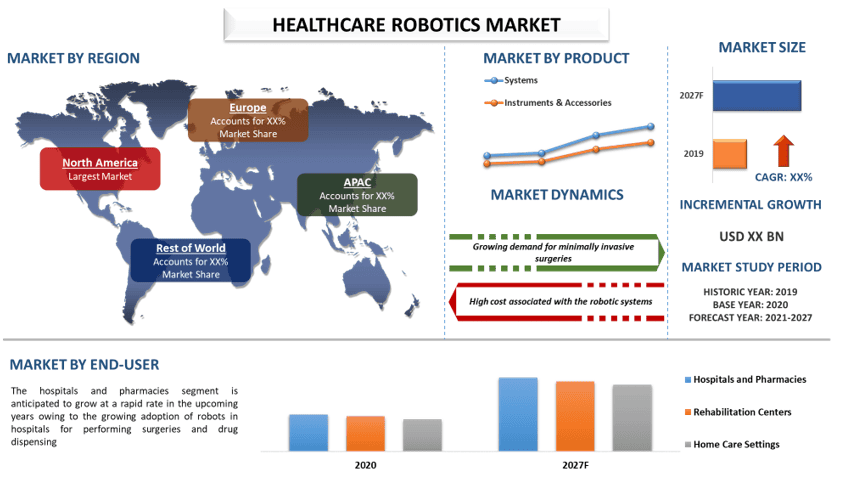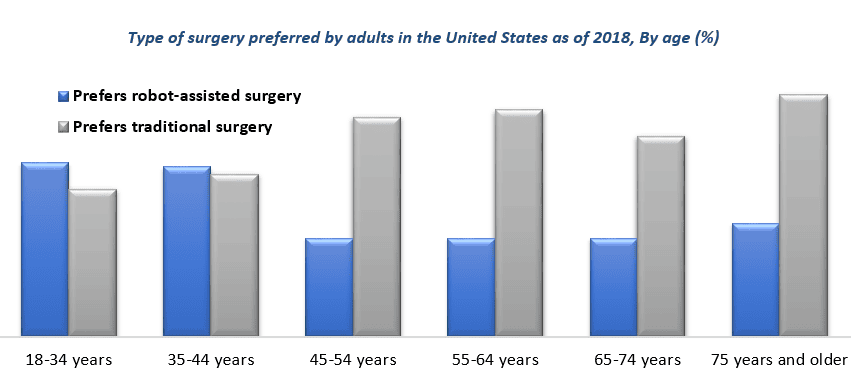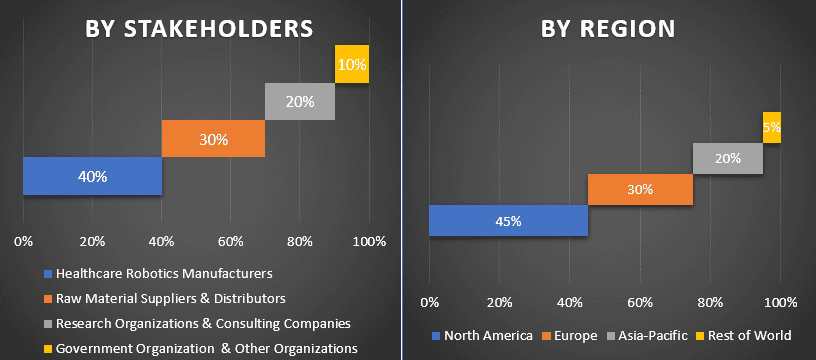- Accueil
- À propos de nous
- Industrie
- Services
- Lecture
- Contactez-nous
Marché de la robotique de santé : Analyse actuelle et prévisions (2021-2027)
Accent mis sur le produit (systèmes (robots chirurgicaux, robots de diagnostic, robots hospitaliers et pharmaceutiques, robots de réadaptation, et autres), instruments et accessoires) ; Utilisateurs finaux (hôpitaux et pharmacies, centres de réadaptation, établissements de soins à domicile) ; Région/Pays

DEMANDER UN EXEMPLE DE PDF GRATUIT
Le marché mondial de la robotique de santé devrait croître à un TCAC élevé d'environ 15 % au cours de la période de prévision (2021-2027). Les robots de santé sont parfaitement conçus avec un mélange de médecine et de technologie. Ces robots permettent aux chirurgiens de réaliser des interventions chirurgicales avec une précision quasi parfaite et sont considérés comme une méthode alternative aux interventions chirurgicales mini-invasives.
Avec les progrès rapides de la technologie médicale et la sensibilisation accrue de la population à l'utilisation de technologies nouvelles et innovantes, de nombreux acteurs de l'industrie se concentrent sur l'expansion de leur portefeuille de produits en lançant de nouveaux produits sur le marché, ce qui explique pourquoi le marché de la robotique de santé connaît un essor dans le monde entier. Par exemple, en novembre 2021, l'hôpital Max a lancé le robot chirurgical Da Vinci Xi dans les hôpitaux pour réaliser des interventions chirurgicales mini-invasives assistées par robot. Ce robot permet aux chirurgiens de réaliser des interventions chirurgicales complexes avec une précision et une flexibilité accrues dans diverses disciplines telles que l'oncologie, l'urologie, l'accès minimal, la chirurgie bariatrique et robotique, la gynécologie, la chirurgie générale et la chirurgie thoracique, entre autres.
En outre, la demande de robots de santé augmente en raison de la pénétration croissante des technologies de pointe et de l'adoption croissante des chirurgies robotiques en raison de l'efficacité accrue et du taux de réussite de ces chirurgies, ainsi que de la nature « mini-invasive » des chirurgies. Cela ressort clairement du fait qu'entre 2016 et 2021, l'industrie mondiale de la santé a commandé 38 400 unités robotiques. De plus, le développement de l'infrastructure informatique de la santé dans divers pays en développement et les investissements continus dans le secteur de la santé, en particulier pour le développement d'une technologie avancée et plus efficace capable de fournir un traitement abordable et rapide aux patients, devraient également propulser le marché de la robotique de santé dans un avenir proche.

Accuray Incorporated, Auris Health Inc., Stryker Corporation, Becton, Dickinson, and Company, Agilent Technologies Inc., FUJIFILM Holdings Corporation, Medtronic plc, Smith & Nephew plc, Intuitive Surgical Inc., Siemens Healthineers AG, sont quelques-uns des acteurs majeurs opérant sur le marché de la robotique de santé. Plusieurs fusions et acquisitions ainsi que des partenariats ont été entrepris par ces acteurs pour faciliter l'accès des clients à de nouveaux robots médicaux avancés.
Aperçus présentés dans le rapport
« Parmi les produits, le segment des systèmes détient la part la plus importante »
En fonction du produit, le marché de la robotique de santé est segmenté en systèmes et instruments et accessoires. Le segment des systèmes représentait une part de marché importante en 2020 et devrait croître considérablement au cours de la période de prévision. Ce segment est en outre sous-segmenté en robots chirurgicaux, robots de diagnostic, robots hospitaliers et pharmaceutiques, robots de réadaptation et autres. La croissance de ce segment peut être attribuée à l'adoption croissante de divers types de systèmes robotiques et aux lancements fréquents de produits sur le marché. Par exemple, en 2019, BIONIK Laboratories Corp. a lancé le système robotique InMotion ARM/HAND de nouvelle génération. Ce système a été développé pour aider les patients souffrant de troubles de la mobilité et pour améliorer la réadaptation des survivants d'un AVC.
« Parmi les utilisateurs finaux, le segment des hôpitaux et des pharmacies détient la part la plus importante »
En fonction des utilisateurs finaux, le marché de la robotique de santé est divisé en hôpitaux et pharmacies, centres de réadaptation et établissements de soins à domicile. Le segment des hôpitaux et des pharmacies a accaparé la plus grande part de marché en 2020 et devrait croître à un TCAC lucratif dans les années à venir en raison de l'adoption croissante de robots dans les hôpitaux pour effectuer des interventions chirurgicales, car les robots médicaux permettent aux chirurgiens de manipuler plus habilement les instruments chirurgicaux ou les cathéters à l'intérieur du corps du patient lors d'interventions chirurgicales mini-invasives. En outre, les robots médicaux sont utilisés dans les pharmacies du monde entier pour la distribution de médicaments en raison de leur efficacité et de leur vitalité, ce qui, à son tour, stimule également la croissance de ce segment.
« L'Amérique du Nord représente l'un des plus grands marchés de la robotique de santé »
Pour une meilleure compréhension de la dynamique du marché de la robotique de santé, une analyse détaillée a été menée pour différentes régions du monde, notamment l'Amérique du Nord (États-Unis, Canada et reste de l'Amérique du Nord), l'Europe (Allemagne, France, Espagne, Royaume-Uni, Italie et reste de l'Europe), l'Asie-Pacifique (Chine, Inde, Japon et reste de l'Asie-Pacifique), le reste du monde. L'Amérique du Nord constitue un marché majeur pour l'industrie de la robotique de santé en 2020 en raison de la présence d'acteurs de marché bien établis dans la région et des lancements fréquents de produits.
Raisons d'acheter ce rapport :
- L'étude comprend une analyse de la taille et des prévisions du marché validée par des experts clés authentifiés de l'industrie
- Le rapport présente un aperçu rapide de la performance globale de l'industrie en un coup d'œil
- Le rapport couvre une analyse approfondie des pairs de l'industrie avec un accent principal sur les finances clés de l'entreprise, le portefeuille de produits, les stratégies d'expansion et les développements récents
- Examen détaillé des moteurs, des contraintes, des tendances clés et des opportunités qui prévalent dans l'industrie
- L'étude couvre de manière exhaustive le marché à travers différents segments
- Analyse approfondie au niveau régional de l'industrie
Options de personnalisation :
Le marché mondial de la robotique de santé peut être personnalisé davantage selon les besoins ou tout autre segment de marché. En outre, UMI comprend que vous pouvez avoir vos propres besoins commerciaux, alors n'hésitez pas à communiquer avec nous pour obtenir un rapport qui répond parfaitement à vos besoins.
Table des matières
Méthodologie de recherche pour l'analyse du marché mondial de la robotique médicale (2021-2027)
L'analyse du marché historique, l'estimation du marché actuel et la prévision du marché futur du marché mondial de la robotique médicale ont été les trois principales étapes entreprises pour créer et analyser l'adoption de la robotique médicale dans les principales régions du monde. Une recherche secondaire exhaustive a été menée pour collecter les chiffres du marché historique et estimer la taille actuelle du marché. Deuxièmement, pour valider ces informations, de nombreuses conclusions et hypothèses ont été prises en considération. De plus, des entretiens primaires exhaustifs ont également été menés avec des experts de l'industrie à travers la chaîne de valeur du marché mondial de la robotique médicale. Après l'hypothèse et la validation des chiffres du marché par le biais d'entretiens primaires, nous avons utilisé une approche descendante/ascendante pour prévoir la taille complète du marché. Par la suite, des méthodes de ventilation du marché et de triangulation des données ont été adoptées pour estimer et analyser la taille du marché des segments et sous-segments auxquels l'industrie appartient. La méthodologie détaillée est expliquée ci-dessous :
Demander plus de détails sur la méthodologie de recherche
Analyse de la taille du marché historique
Étape 1 : Étude approfondie des sources secondaires :
Une étude secondaire détaillée a été menée pour obtenir la taille du marché historique de la robotique médicale à travers des sources internes à l'entreprise telles que le rapport annuel et les états financiers, les présentations de performance, les communiqués de presse, etc., et des sources externes, notamment les revues, les actualités et les articles, les publications gouvernementales, les publications des concurrents, les rapports sectoriels, les bases de données tierces et autres publications crédibles.
Étape 2 : Segmentation du marché :
Après avoir obtenu la taille du marché historique du marché de la robotique médicale, nous avons mené une analyse secondaire détaillée pour recueillir des informations sur le marché historique et les parts des différents segments et sous-segments pour les principales régions. Les principaux segments inclus dans le rapport sont le produit et l'utilisateur final. De plus, des analyses au niveau des pays ont été menées pour évaluer l'adoption globale de la robotique médicale à travers le monde.
Étape 3 : Analyse des facteurs :
Après avoir acquis la taille du marché historique des différents segments et sous-segments, nous avons mené une analyse des facteurs détaillée pour estimer la taille actuelle du marché de la robotique médicale. De plus, nous avons mené une analyse des facteurs à l'aide de variables dépendantes et indépendantes telles que les avancées technologiques dans le secteur de la santé et la demande croissante d'opérations médicales améliorées dans le monde. Une analyse approfondie a été menée pour les scénarios de demande et d'offre en tenant compte des principaux partenariats, fusions et acquisitions, de l'expansion des activités et des lancements de produits dans le secteur de la robotique médicale à travers le monde.
Estimation et prévision de la taille actuelle du marché
Taille actuelle du marché : Sur la base des informations exploitables tirées des 3 étapes ci-dessus, nous sommes parvenus à la taille actuelle du marché, aux principaux acteurs du marché de la robotique médicale et aux parts de marché des segments. Tous les pourcentages de parts requis et les ventilations du marché ont été déterminés à l'aide de l'approche secondaire mentionnée ci-dessus et ont été vérifiés par le biais d'entretiens primaires.
Estimation et prévision : Pour l'estimation et la prévision du marché, des pondérations ont été attribuées à différents facteurs, notamment les moteurs et les tendances, les contraintes et les opportunités disponibles pour les parties prenantes. Après avoir analysé ces facteurs, les techniques de prévision pertinentes, c'est-à-dire l'approche descendante/ascendante, ont été appliquées pour arriver à la prévision du marché vers 2027 pour différents segments et sous-segments à travers les principaux marchés mondiaux. La méthodologie de recherche adoptée pour estimer la taille du marché comprend :
- La taille du marché de l'industrie, en termes de valeur (US$) et le taux d'adoption de la robotique médicale à travers les principaux marchés nationaux
- Tous les pourcentages de parts, les divisions et les ventilations des segments et sous-segments de marché
- Les principaux acteurs du marché de la robotique médicale en termes de produits offerts. De plus, les stratégies de croissance adoptées par ces acteurs pour rivaliser sur le marché en croissance rapide
Validation de la taille et de la part du marché
Recherche primaire : Des entretiens approfondis ont été menés avec les principaux leaders d'opinion (KOL), y compris les cadres supérieurs (CXO/VP, chef des ventes, chef du marketing, chef des opérations et chef régional, chef de pays, etc.) à travers les principales régions. Les résultats de la recherche primaire ont ensuite été résumés et une analyse statistique a été effectuée pour prouver l'hypothèse énoncée. Les contributions de la recherche primaire ont été consolidées avec les résultats secondaires, transformant ainsi l'information en informations exploitables.
Répartition des participants primaires dans différentes régions

Ingénierie du marché
La technique de triangulation des données a été utilisée pour compléter l'estimation globale du marché et pour arriver à des chiffres statistiques précis de chaque segment et sous-segment du marché de la robotique médicale. Les données ont été divisées en plusieurs segments et sous-segments après avoir étudié divers paramètres et tendances dans les domaines du produit et de l'utilisateur final du marché de la robotique médicale.
L'objectif principal de l'étude du marché de la robotique médicale
Les tendances actuelles et futures du marché de la robotique médicale ont été mises en évidence dans l'étude. Les investisseurs peuvent obtenir des informations stratégiques pour fonder leur discrétion en matière d'investissements à partir de l'analyse qualitative et quantitative effectuée dans l'étude. Les tendances actuelles et futures du marché ont déterminé l'attractivité globale du marché au niveau régional, offrant une plate-forme aux participants industriels pour exploiter le marché inexploité afin de bénéficier d'un avantage de premier arrivé. Les autres objectifs quantitatifs des études comprennent :
- Analyser la taille actuelle et prévue du marché de la robotique médicale en termes de valeur (US$). De plus, analyser la taille actuelle et prévue du marché des différents segments et sous-segments
- Les segments de l'étude comprennent les domaines du produit et de l'utilisateur final
- Définir et analyser le cadre réglementaire de l'industrie de la robotique médicale
- Analyser la chaîne de valeur impliquée avec la présence de divers intermédiaires, ainsi qu'analyser les comportements des clients et des concurrents de l'industrie
- Analyser la taille actuelle et prévue du marché de la robotique médicale pour la principale région
- Les principales régions étudiées dans le rapport comprennent l'Amérique du Nord, l'Europe, l'Asie-Pacifique et le reste du monde
- Profils d'entreprise du marché de la robotique médicale et stratégies de croissance adoptées par les acteurs du marché pour se maintenir sur le marché en croissance rapide
- Analyse régionale approfondie de l'industrie
Connexes Rapports
Les clients qui ont acheté cet article ont également acheté










